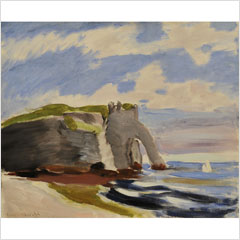
動画による作品解説
アンリ・マティス
エトルタ断崖
1920年 油彩・カンヴァス 38.0×46.3cm
Henri Matisse
The Cliffs at Etretat
Les falaises à Etretat
1920, Oil on canvas, 38.0 × 46.3 cm
ドーヴァー海峡に面したエトルタは、白亜の断崖が切り立つ小さな漁村です。村のはずれには波蝕によって生み出された「象の鼻」と呼ばれる断崖があり、ドラクロワやクールベ、コロー、モネなど多くの画家がモティーフとしてきました。マティスは1920年と21年の夏にこの地を訪れて、「象の鼻」を多くの作品に描きました。
空にはノルマンディーの低い雲が流れ、断崖の沖にはヨットが浮かぶ夏の情景が描き出されています。マティスはこの時期、明暗をあらわす灰色や茶色などの中間色を多用しました。それらと黒を併置することで、一見暗い色調の灰色や茶色は美しい輝きを帯び、色彩を引き立たせています。海の水面(みなも)は水色と黄土色、黒の線のみで表現されていますが、ノルマンディーの海がもつ千変万化するやわらかな色調を見事にあらわしています。
Étretat, facing the English Channel, is a small fishing village with towering white chalk cliffs. At the edge of the village, there is a cliff known as the 'Elephant's Trunk,' created by wave erosion, which has been a motif for many painters such as Delacroix, Courbet, Corot, and Monet. Matisse visited this place in the summers of 1920 and 1921 and depicted the 'Elephant's Trunk' in many of his works.
The painting portrays a summer scene with low Normandy clouds drifting in the sky and yachts floating off the cliffs. During this period, Matisse frequently used intermediate colors such as grays and browns to represent light and shadow. By juxtaposing these with black, the seemingly dark tones of gray and brown take on a beautiful brilliance, enhancing the colors. The surface of the sea is expressed with only light blue, ochre, and black lines, yet it wonderfully captures the ever-changing soft hues of the Normandy sea.

